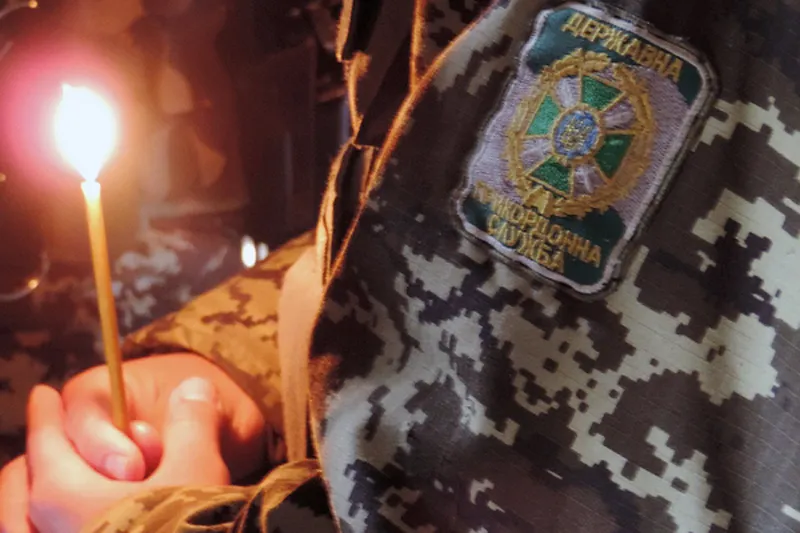Things to know about the Catholic Church in Ukraine.
 Prayer candle at a Military Chaplaincy in Ukraine. Photo Courtesy of Aid to the Church in Need. / null
Prayer candle at a Military Chaplaincy in Ukraine. Photo Courtesy of Aid to the Church in Need. / null
Denver Newsroom, Feb 24, 2022 / 11:51 am (CNA).
Though most of Ukraine’s population is Eastern Orthodox, Catholics are among those suffering amid Russia’s invasion of the country. Russian military entered Ukraine at several points on Thursday, and missile strikes on military targets and cities were also reported.
Here is what to know about Ukraine’s Catholic population:
Ukrainian Greek Catholic Church
About 9 percent of Ukrainians are Greek Catholics, meaning they are Catholics who belong to Churches of the Byzantine rite. Virtually all of these are part of the Ukrainian Greek Catholic Church, which is led by Major Archbishop Sviatoslav Shevchuck of the Ukrainian Archeparchy of Kyiv-Halych.
The Byzantine rite celebrates the liturgy in the form used by the Eastern Orthodox Churches, regularly using the Divine Liturgy of St. John Chrysostom.
Ukrainian Greek Catholics are concentrated in the country’s western oblasts bordering Poland, particularly Lviv. There are, however, 16 eparchies or exarchates (equivalent to dioceses or vicariates) of the Church throughout the country, including in Crimea, Luhansk, and Donetsk.
The Ukrainian Greek Catholic Church is rooted in the 10th century Christianization of Kievan Rus’, a state whose heritage Ukraine, Russia, and Belarus all claim. That event also forms the roots of the Russian Orthodox Church, the Ukrainian Orthodox Church (Moscow Patriarchate), and the Orthodox Church in Ukraine.
This Church also has a diaspora, with a sizable presence in the U.S., Canada, Poland, and Brazil, and smaller communities elsewhere in Europe, and in Argentina and Australia.
Latin rite Catholics
There is also a Latin, or Roman, rite hierarchy in Ukraine, to which about 1 percent of the population belongs. This is also concentrated in the west of the country, with six dioceses being suffragan to the Archdiocese of Lviv, and it has cultural ties to Poland and Hungary.
Others
Ukraine is also home to the Ruthenian Catholic Eparchy of Mukachevo, and the Armenian Catholic Archeparchy of Lviv.
The Ruthenian Catholic Church also uses the Byzantine rite, and it is centered in an oblast that borders four of Ukraine’s western neighbors. There are nearly 320,000 Catholics in the Mukachevo eparchy, who are served by about 300 priests.
There is an Armenian Catholic Archeparchy in Lviv, though it has been vacant since World War II. Armenian Catholics in Ukraine are few in number, and are often entrusted to the pastoral care of priests of other Catholic Churches.
Persecution
Catholic Churches were severely persecuted in Ukraine while the country was part of the Soviet Union, and the renewal of conflict between Russia and Ukraine in the 2010s brought with it fears of ecclesial conflict and persecution.
The Ukrainian Greek Catholic Church was outlawed under Soviet rule, from 1946 to 1989, and the Ruthenian Catholic Church was suppressed in 1949.
In 2014, after the Russian annexation of Crimea and armed conflicts in other border regions between Ukrainian military forces, and pro-Russian rebel groups and Russian soldiers, the then-apostolic nuncio to Ukraine warned of a return of persecution because of Russia’s expansion into Ukrainian territory.
“The danger of repression of the Greek-Catholic Church exists in whatever part of Ukraine Russia might establish its predominance or continue through acts of terrorism to push forward with its aggression,” Archbishop Thomas Gullickson said Sept. 23, 2014.
Archbishop Gullickson was nuncio to Ukraine from 2011 to 2015, and he retired in 2020, at age 70.
“Any number of statements emanating from the Kremlin of late leave little doubt of Russian Orthodox hostility and intolerance toward Ukrainian Greek-Catholics,” he said in September 2014 to directors of Aid to the Church in Need.
“There is no reason for excluding the possibility of another wholesale repression of the Ukrainian Greek-Catholic Church as came about in 1946 with the complicity of the Orthodox brethren and the blessing of Moscow,” he stated.
Many Roman Catholic and Greek Catholic clergy were forced to leave Crimea after its annexation. Both Roman and Greek Catholics faced difficulties in properly registering ownership of church property and in ensuring legal residency for their clergy.
Under the Soviet Union, 128 priests, bishops, and nuns of the Ruthenian Catholic Church were put in prisons or sent into exile in Siberia. The eparchy of Mukachevo had 36 priests martyred during the persecution.
Blessed Theodore Romzha was Ruthenian Bishop of Mukachevo for three years before he was assassinated in 1947 by the NKVD on the orders of Nikita Khrushchev, who was then first secretary of the Communist Party of Ukraine.
Blessed Romzha was among a group of more than 20 Ukrainian martyrs of the 20th century who were beatified by St. John Paul II during his 2001 visit to Ukraine.